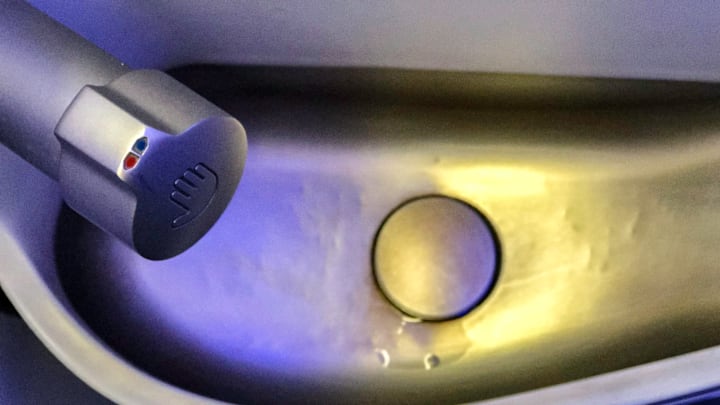Is it really necessary to wash your hands on a plane? Some experts argue that washing your hands mid-flight might not be as crucial as we think: While airplanes are germ-infested environments—which would naturally make hand washing a priority—the water in airplane sinks isn’t always as clean as you’d hope, potentially making the habit more harmful than helpful.
- The Miracle and Mess of Flying
- The Water Problem
- Hand Washing vs. Sanitizer
- How to Avoid Germs on Flights
The Miracle and Mess of Flying
Flying has always been a mix of glamor and grime. There’s the thrill of takeoff, the views from 30,000 feet, and the convenience of arriving somewhere new in hours. But there are also cramped seats, recycled air, and surfaces touched by hundreds of strangers.
From tray tables to seat pockets, everything on board can harbor germs. And of all the questionable areas on a plane, the bathroom may be the most suspicious—particularly the sink’s handle, which, according to swab tests by the Washington Post, is the dirtiest part of a plane.

Airplane lavatories aren’t completely ignored by cleaning crews. Toilets usually get attention, but as flight attendant and blogger Josephine Remo told Travel + Leisure, the high-touch areas—latches, locks, and door handles—often don’t. Those are exactly the spots passengers touch before and after washing their hands (if they wash their hands).
So even if the bathroom looks clean at first glance, the parts you handle most are probably still crawling with bacteria.
You Might Also Like ...
- 10 of the Scariest Airplane Landings in the World
- Why Are Airplane Windows Round?
- 12 Ways Airports Are Secretly Manipulating You
Add Mental Floss as a preferred news source!
The Water Problem
The bigger issue may be the water itself. One 2017 study, which appeared in the Annals of Microbiology, tested ice made for flights and found more than 50 strains of bacteria. Two years later, Hunter College NYC Food Policy Center at the City University of New York performed a water quality analysis and found that water procured from several major airlines contained E. coli and other bacteria. The water isn’t necessarily obtained from sanitary sources, and the containers carrying it might not be sanitized, either.
That’s why experts say you should never drink plane water. They also recommend skipping drinks that could be made with that water, like coffee and tea. Charles Platkin, head of the Hunter College NYC Food Policy Center, told Travel + Leisure that he not only avoids plane coffee and tea—he won’t even wash his hands in the sink, preferring wipes and sanitizer instead.
Hand Washing vs. Sanitizer
This all means that when you’re flying, a quick rinse under that airplane faucet may not be worth the gamble. As Janilyn Hutchings, Certified Professional in Food Safety, told Smarter Travel, while soap, water, and a 15-second scrub are generally preferable to sanitizer, that’s only if the water you’re using is potable.

“In general, washing your hands in non-potable water isn’t very effective in cleaning your hands,” she said. “If you know for a fact clean water is unavailable, using an alcohol-based hand sanitizer may be your best option.” Then, once you’re on the ground, hit the bathroom and wash your hands thoroughly with clean, running water.
Contaminated water doesn’t always cause illness, but when it does, it can ruin an entire vacation. So while using a small bottle of sanitizer may not feel glamorous, compared to losing your trip to a stomach bug, it’s a smart trade-off.
How to Avoid Germs on Flights

There are things you can do to guard against germs both before and during flights—here are just a few of them:
- Nabbing an aisle seat might be tempting, but when you’re booking, consider getting a window seat instead—it puts you at a distance from people walking up and down the aisle (and any germs they might be harboring).
- Disinfect the seat, tray tables, and arm rests with wipes or sanitizer.
- Once you’re settled in your seat, turn that air vent on full blast and point it toward yourself to keep that airflow moving. You might also want to consider wearing a mask, and you should avoid touching your face.
- Bring your own snacks so you don’t have to touch packaging that might be dirty.
